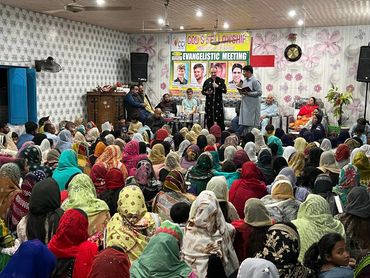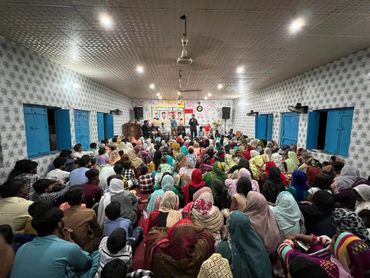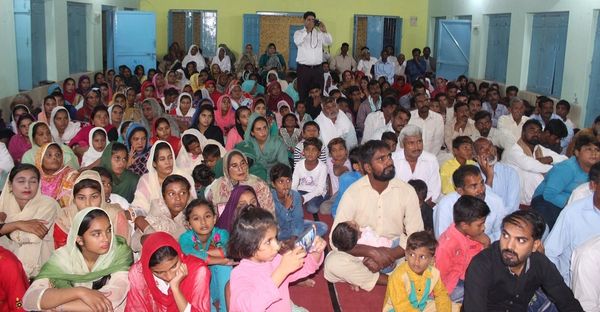why IS EVANGELISM needed in Pakistan?
Additional Information about Pakistan
Pakistan, officially the Islamic Republic of Pakistan, is a country in South Asia. It is the world’s sixth-most populous country with a population exceeding 212.7 million people. In area, it is the 33rd-largest country, spanning 881,913 square kilometres. Pakistan has a 1,046-kilometre (650-mile) coastline along the Arabian Sea and Gulf of Oman in the south and is bordered by India to the east, Afghanistan to the west, Iran to the southwest, and China in the northeast. It is separated narrowly from Tajikistan by Afghanistan's Wakhan Corridor in the northwest, and also shares a maritime border with Oman. Christians make up one of the two largest (non-Muslim) religious minorities in Pakistan, along with Hindus.
Islam is the largest and the state religion of the Islamic Republic of Pakistan.[3] Pakistan has been called a "global center for political Islam".[4 About 97% of Pakistanis are Muslims.[5] Pakistan has the second largest number of Muslims in the world after Indonesia.[6][7] The majority are Sunni (80%)[8][9][10][11][12] while Shias make up between 15–20%[13][14][15][16][17] and Ahmadis (considered by the constitution of Pakistan to be non-Muslims) are 1%.[18].The total number of Christians in Pakistan was estimated at 3.9 million in 2018, or 2% of the population.[1] Of these, approximately half are Catholic and half Protestant. A small number of Eastern Orthodox Christians also live in Pakistan (see Eastern Orthodoxy in Pakistan).[2][3][4]
Languages
First languages of Pakistan[515]Punjabi 48%Sindhi 12%Saraiki 10%Pashto 8%Urdu 8%Balochi 3%others 11%Main article: Languages of Pakistan
More than sixty languages are spoken in Pakistan, including a number of provincial languages. Urdu—the lingua franca and a symbol of Muslim identity and national unity—is the national language understood by over 75% of Pakistanis. It is the main medium of communication in the country but the primary language of only 8% of Pakistan's population.[12][11][516] Urdu and English are the official languages of Pakistan, with English primarily used in official business and government, and in legal contracts;[198] the local variety is known as Pakistani English. The Punjabi language, the most common in Pakistan and the first language of 44.2% of Pakistan's population,[517] is mostly spoken in the Punjab. Saraiki, mainly spoken in South Punjab and Hindko, is predominant in the Hazara region of Khyber Pakhtunkhwa. Pashto is the provincial language of Khyber Pakhtunkhwa and is well understood in Sindh and Balochistan.[10] The Sindhi language is commonly spoken in Sindh while the Balochi language is dominant in Balochistan. if you want to know more about languages in Pakistan then visit this site https://en.wikipedia.org/wiki/Languages_of_Pakistan
Immigration
Main article: Immigration to Pakistan Pakistan hosts the second largest refugee population globally after Turkey.[521] An Afghan refugee girl near Tarbela Dam
Even after partition in 1947, Indian Muslims continued to migrate to Pakistan throughout the 1950s and 1960s, and these migrants settled mainly in Karachi and other towns of Sindh province.[522] The wars in neighboring Afghanistan during the 1980s and 1990s also forced millions of Afghan refugees into Pakistan. The Pakistan Census excludes the 1.41 million registered refugees from Afghanistan,[523] who are found mainly in the Khyber-Pakhtunkhwa and tribal belt, with small numbers residing in Karachi and Quetta. Pakistan is home to one of the world's largest refugee populations.[524] In addition to Afghans, around 2 million Bangladeshis and half a million other undocumented people live in Pakistan. They are claimed to be from other areas such as Myanmar, Iran, Iraq, and Africa.[525]. If you want to know more about this then go to this website https://en.wikipedia.org/wiki/Immigration_to_Pakistan
eTHNIC GROUP
Ethnic groups
Ethnic groups in Pakistan14] Punjabi 44.7%Pashtun (Pathan) 15.4%Sindhi 14.1%Saraiki 8.4%Muhajir 7.6%Balochi 3.6%others 6.3%[14]Punjabi 44.7%Pashtun (Pathan) 15.4%Sindhi 14.1%Saraiki 8.4%Muhajir 7.6%Balochi 3.6%others 6.3%
The population is dominated by four main ethnic groups: Punjabis, Pashtuns (Pathans), Sindhis, and Balochs.[531] Rough accounts from 2009 indicate that the Punjabis dominate with 78.7 million (~45%) while the Pashtuns are the second-largest group with ~29.3 million (15.4%).[531] The number of Sindhis is estimated at 24.8 million (14.1%), with the number of Seraikis (a sub-group of Punjabis) estimated at 14.8 million (8.4%).[531] The number of Urdu-speaking Muhajirs (the Indian emigrants) stands at ~13.3 million (7.6%) while the number of Balochs is estimated at 6.3 million (3.6%)—the smallest group in terms of population.[531][532] The remaining 11.1 million (4.7%) consist of various ethnic minorities such as the Brahuis,[518] the Hindkowans, the various peoples of Gilgit-Baltistan, the Kashmiris, the Sheedis (who are of African descent),[533] and the Hazaras.[531] There is also a large Pakistani diaspora worldwide, numbering over seven million,[532] which has been recorded as the sixth largest diaspora in the world.[534]. if you want to know more about this go to this website https://en.wikipedia.org/wiki/Administrative_units_of_Pakistan
Through the Eyes of the Devout: A Gallery of Religious Experiences
mission trio 2023 pakistan evangelistic meeting Dhoda






Emmanuel Doulat 2023 Mission trip Pakistan Dhoda meeting
Thank to all of your for praying for our mission trip . blessings to all of you. Emmanuel Doulat
29th March 2023 Mission trip Pakistan
1/6
Video 2023 March 29th, pakistan mission trip Emmanuel Doulat
Mission Report 2023 Pakistan Check out this great video
Rev. lafayette scale and Evan. Keith Begley preaching EVANGELISTIC prayer festival Asal Sulman pakistan sept-oct 2019 MISSION TRIP












REV. LAFAYETTE SCALE AND EVAN. KEITH BEGLEY PREACHING EVANGELISTIC PRAYER FESTIVAL mehar town PAKISTAN SEPT-OCT 2019 MISSION TRIP
REV. LAFAYETTE SCALE AND EVAN. KEITH BEGLEY PREACHING EVANGELISTIC PRAYER FESTIVAL NARROWal PAKISTAN SEPT-OCT 2019 MISSION TIRP

REV. LAFAYETTE SCALE PREACHING IN 116TH sIALKOT EVANGELISTIC cONVENTION IN sIALKOT PAKISTAN SEPT-OCT 2019 MISSION TRIP
EVAN. KEITH BEGLEY AND pASTOR eMMANUEL dOULAT ARE PREACHING IN EVANGELISTIC PRAYER FESTIVAL AT dHODA PAKISTAN SEPT-OCT 2019 MISSION TIRP

BAPTISM during mission trip sept-oct. 2019

Rev. Richard Showalter and Emmanuel Doulat preaching at brick kiln place in evangelistic meeting april 2019 pakistan


Rev. Richard Showalter and Emmanuel Doulat preaching in Evangelistic meeting at brick kiln place in april 2019 trip pakistan
REV. RICHARD SHOWALTER AND EMMANUEL DOULAT PREACHING IN EVANGELISTIC MEETING different places Dodha and Narrowal IN APRIL 2019 TRIP PAKISTAN




dr. Brian adams and emmanuel doulat preaching the Gospel in Evangelistic meetings , narrowal , gujranwala, sialkot, pakistan 2018




















Dr. Brian Adams and Emmanuel doulat preaching the gospel in evangelistic meetings islam-baad, kharian , shakar ghar , pakistan 2018













Pastor Mansab Ul Haque BAPTIZING Muridkay pakistan ,2010, 2013


















































